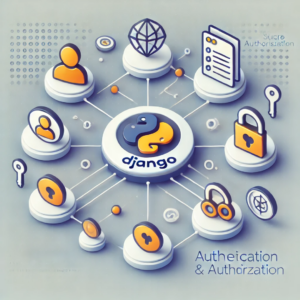
Authentication is the process of verifying a user’s identity using a cloud identity platform. It ensures that users are who they claim to be. For instance, when a user logs in with a username and password, the system checks these credentials against stored data to confirm their identity.
Authorization on the other hand, determines what an authenticated user is allowed to do. After a user is authenticated, the system checks their permissions to grant or deny access to specific resources or actions within the application. Understanding IAM in cloud computing is essential for controlling access to sensitive data and functionalities.
Django provides built-in support for both authentication and authorization, making it easier for developers to integrate these features without starting from scratch.
Setting Up the IAM in Cloud Computing Authentication System
To implement authentication in Django, we will create an accounts app that will handle user signup, login, and logout functionalities. Here are the steps to set up the authentication system:
Step 1: Create the Accounts App
First, we need to create a new Django app called accounts. This app will contain all the views and templates related to user authentication.
Run the following command:
python manage.py startapp accountsNext, add the accounts app to the INSTALLED_APPS list in your settings.py file:
INSTALLED_APPS = [ ... 'accounts', ]Step 2: Create URLs for the Accounts App
In the accounts directory, create a new file named urls.py to define the URL patterns for the authentication views in the cloud identity platform:
from django.urls import path
from . import views
urlpatterns = [
path('signup/', views.signup, name='accounts.signup'),
path('login/', views.login, name='accounts.login'),
path('logout/', views.logout, name='accounts.logout'),
]Include the accounts URLs in the project’s main urls.py file:
from django.urls import include, path
urlpatterns = [
path('admin/', admin.site.urls),
path('accounts/', include('accounts.urls')),
...
]Step 3: Implement User Signup
The signup view allows new users to create an account using a cloud identity platform. We will use Django’s built-in UserCreationForm to handle user registration.
In views.py, implement the signup function:
from django.shortcuts import render, redirect
from django.contrib.auth.forms import UserCreationForm
def signup(request):
if request.method == 'POST':
form = UserCreationForm(request.POST)
if form.is_valid():
form.save()
return redirect('accounts.login')
else:
form = UserCreationForm()
return render(request, 'accounts/signup.html', {'form': form})Create a template for the signup page in accounts/templates/accounts/signup.html:
{% extends 'base.html' %}
{% block content %}Sign Up
{% endblock %}Step 4: Implement User Login
Next, we need to create a login view that authenticates users using their credentials with a cloud identity platform.
In views.py, add the login function:
from django.contrib.auth import authenticate, login as auth_login
def login(request):
if request.method == 'POST':
username = request.POST['username']
password = request.POST['password']
user = authenticate(request, username=username, password=password)
if user is not None:
auth_login(request, user)
return redirect('home.index')
else:
return render(request, 'accounts/login.html', {'error': 'Invalid credentials'})
return render(request, 'accounts/login.html')Create the login template in accounts/templates/accounts/login.html:
{% extends 'base.html' %}
{% block content %}Login
{% if error %}{{ error }}
{% endif %}
{% endblock %}Step 5: Implement User Logout
To allow users to log out, we will create a logout view that uses Django’s built-in logout function.
In views.py, add the logout function:
from django.contrib.auth import logout as auth_logout
def logout(request):
auth_logout(request)
return redirect('home.index')Step 6: Protecting Views with Login Required
Django provides a decorator called login_required that can restrict access to certain views with a cloud identity platform. To use this decorator, import it and apply it to any view that requires authentication.
For example:
from django.contrib.auth.decorators import login_required
@login_required
def profile(request):
return render(request, 'accounts/profile.html')This ensures that only authenticated users can access the profile view. If a user who is not logged in tries to access this view, they will be redirected to the login page.
Handling Permissions and Authorization
Django also has a flexible permission system that allows you to control what authenticated users can do. You can define permissions at the model level and check these permissions in your views.
Step 1: Defining Permissions
You can define permissions in your models using the Meta class. For example:
from django.db import models
from django.contrib.auth.models import User
class BlogPost(models.Model):
title = models.CharField(max_length=200)
content = models.TextField()
author = models.ForeignKey(User, on_delete=models.CASCADE)
class Meta:
permissions = [
("can_publish", "Can publish blog posts"),
]Step 2: Checking Permissions in Views
To check if a user has a specific permission, you can use the has_perm method. For example:
from django.http import HttpResponseForbidden
def publish_post(request, post_id):
post = BlogPost.objects.get(id=post_id)
if request.user.has_perm('app_name.can_publish'):
post.publish()
return redirect('blog.index')
else:
return HttpResponseForbidden("You do not have permission to publish this post.")Conclusion
Django’s built-in authentication and authorization system provides a powerful and flexible way to manage user access and permissions in your web applications. By following the steps outlined in this blog post, you can easily implement user signup, login, logout, and permissions management in your Django projects. With a cloud identity platform in place, you can streamline the management of user identities and access across your application.
With these features in place, you can ensure that your application is secure and that users have the appropriate access to the resources they need. Additionally, by incorporating deployment on AWS for Django applications, you can take advantage of cloud-based scalability and security features. As you continue to develop your Django applications, consider exploring more advanced topics such as custom user models, token-based authentication, and third-party authentication providers to further enhance your application’s security and user experience, especially in the context of IAM in cloud computing in the UAE.
Do you like to read more educational content? Read our blogs at Cloudastra Technologies or contact us for business enquiry at Cloudastra Contact Us.